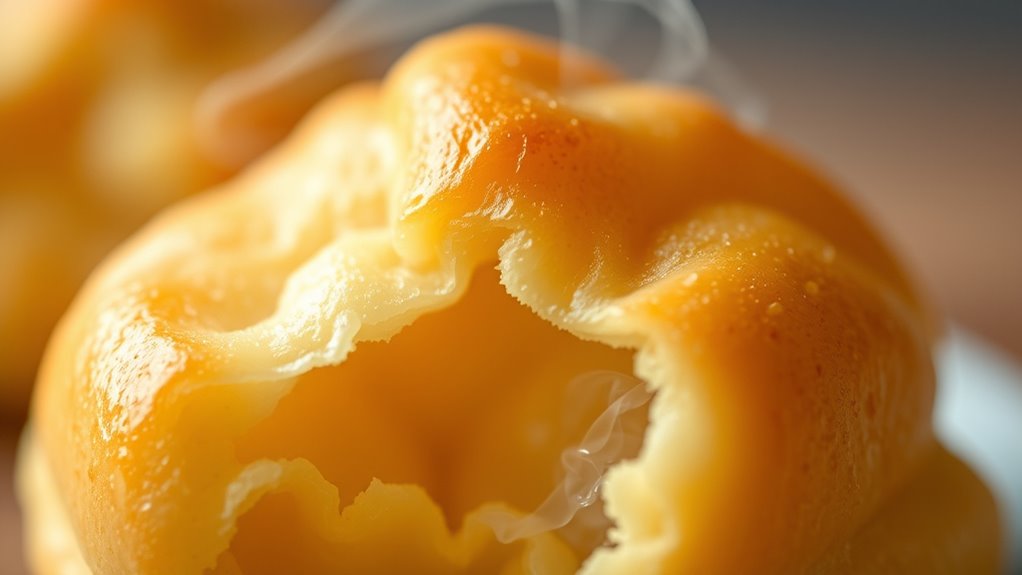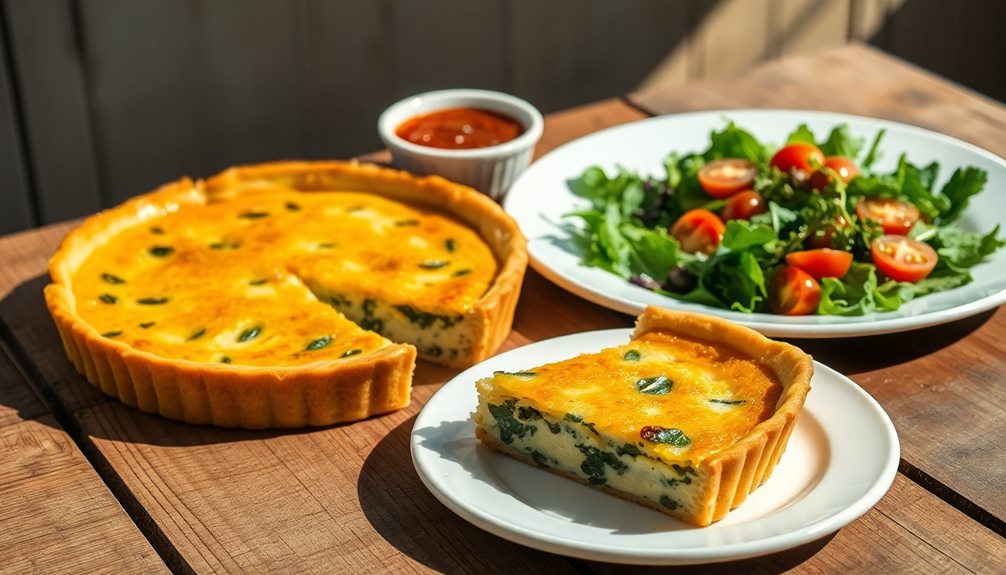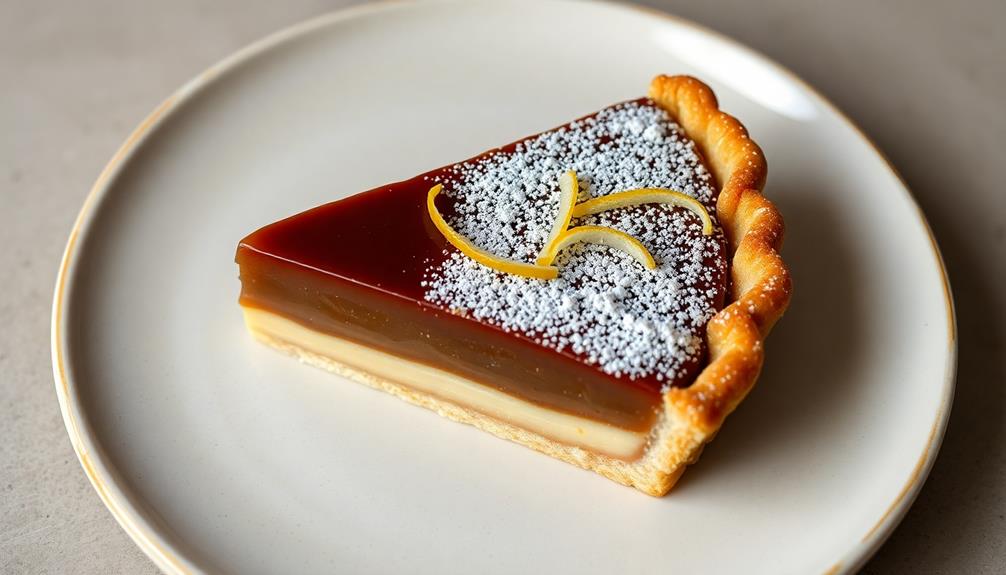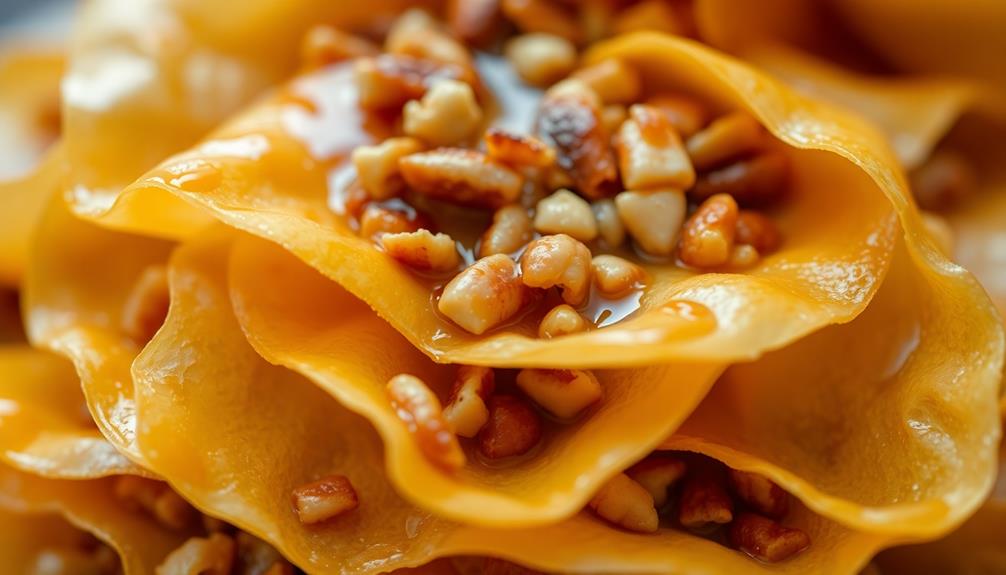To get airy choux pastry every time, focus on understanding steam expansion. Start by making a stiff, glossy dough that traps moisture, and guarantee your oven is preheated to 375°F–400°F. Avoid opening the oven early, so steam stays inside, pushing the dough upward. Controlling temperature and handling the dough properly helps you create the perfect hollow puff. Keep these tips in mind, and you’ll discover how to consistently achieve light, fluffy results with each bake.
Key Takeaways
- Properly prepare the choux dough by thoroughly cooking the flour to develop gluten and trap steam effectively.
- Preheat the oven to a high temperature (375°F–400°F) to generate rapid steam and ensure good puffing.
- Bake without opening the oven early to prevent steam from escaping and collapsing the pastry.
- Maintain consistent oven heat throughout baking to allow proper vaporization and expansion of the dough.
- Cool pastries gradually after baking to preserve the hollow, airy interior created by steam expansion.
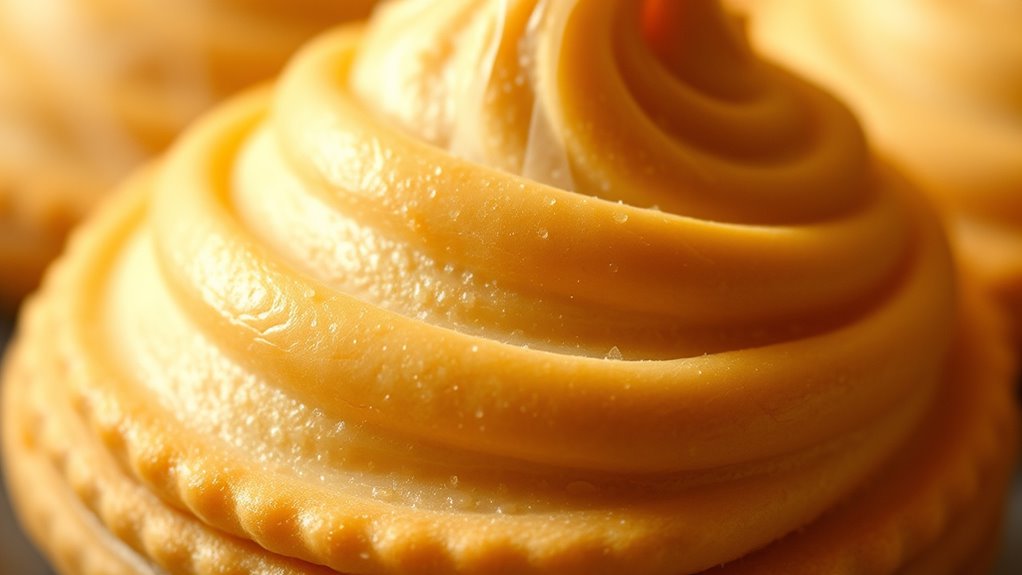
Have you ever wondered what makes choux pastry rise so perfectly? The secret lies in the way steam expands inside the dough during baking, creating that light, airy texture we all love. Mastering this process requires understanding the essential pastry techniques that guarantee your baked goods turn out flawless every time. Whether you’re aiming to make classic éclairs, cream puffs, or profiteroles, knowing how steam works is key to achieving the ideal rise and structure.
Understanding how steam causes choux pastry to rise is key to perfect, airy baked goods every time.
When you prepare choux pastry, the initial mixing is fundamental. You start by boiling water, butter, and a pinch of salt, which creates a hot, saturated environment. Once you add the flour, you stir vigorously to cook off excess moisture and develop gluten, resulting in a smooth, cohesive dough. This step is indispensable because it sets the stage for the steam expansion that follows. The dough should be thick enough to hold its shape but still moist enough to trap steam effectively. This balance is a foundational pastry technique that influences how well your pastry will puff up during baking. Additionally, ensuring the dough is properly cooled before piping can help achieve a better rise.
As you transfer the dough to a piping bag and shape it onto your baking sheet, preheating your oven is equally important. The high temperature, usually around 375°F to 400°F, causes the water content in the dough to rapidly turn into steam once baking begins. This sudden steam generation is what pushes against the dough’s outer shell, causing it to expand and form those distinctive hollow centers. If the oven isn’t hot enough, the steam won’t be generated quickly enough, resulting in dense, flat pastries. Conversely, baking at too high a temperature can cause the outer shell to set before the interior has had a chance to fully expand, leading to uneven rise.
Throughout baking, the steam’s expansion is what creates the signature puffiness of choux pastry. As the water vaporizes, it pushes outward, stretching the dough into a hollow shell. The key is to trap this steam—so avoid opening the oven door too early, as sudden temperature drops can cause the pastry to collapse. Proper oven temperature control is crucial for consistent results. Using techniques to maximize steam retention, such as creating a steamy environment in the oven or avoiding premature opening, can significantly improve your results. Additionally, proper dough handling can help prevent deflation and ensure a uniform rise. Once baked and cooled, the hollow interior should be perfectly airy, a testament to your precise pastry techniques and understanding of steam expansion. Using the right baking techniques ensures that your pastry remains light and delicate.
In essence, mastering the science of steam expansion in choux pastry transforms good recipes into famous recipes that impress every time. By paying attention to dough consistency, oven temperature, and baking time, you harness the power of steam to achieve that signature rise. With practice and a clear grasp of these pastry techniques, you’ll consistently produce light, delicate pastries that showcase the magic of steam-driven puffing.
Frequently Asked Questions
Can Choux Pastry Be Made Without Eggs?
You might wonder if you can make choux pastry without eggs. While traditional recipes rely on eggs for structure and steam expansion, you can try egg alternatives like flaxseed or applesauce for vegan choux. Keep in mind, using these substitutes may affect the texture and rise, but with some experimentation, you can create a delicious vegan choux that’s light and airy. Adjust the recipe until you find the perfect consistency.
How Do Humidity Levels Affect Choux Pastry?
Humidity levels considerably impact choux pastry by influencing moisture content and texture. High humidity increases moisture in the air, which can lead to excess moisture in your dough, making it harder to achieve crisp, airy shells. To combat this, control moisture by storing ingredients properly and baking in a dry environment. Adjust your recipe and handling techniques accordingly to maintain consistent results, ensuring your pastry remains light and perfectly baked every time.
What Is the Ideal Oven Temperature for Puffing?
Imagine you’re in the roaring ’20s, and your secret to perfect choux is the right oven temperature. You should set your oven to around 375°F (190°C) to guarantee proper steam expansion. This temperature allows the water in the dough to turn into steam rapidly, puffing up the pastry. Too hot, and it might burn; too cool, and it won’t puff properly. Trust this balance for airy, crispy choux every time.
Can Choux Pastry Be Frozen Before Baking?
You can freeze choux pastry before baking using proper freezing techniques. Shape your pastry first, then wrap it tightly to prevent freezer burn. When you’re ready to bake, thaw it in the refrigerator or at room temperature using gentle thawing methods. This helps maintain texture and ensures your pastry puffs up perfectly. Just remember, the longer it’s frozen, the more you should minimize handling to keep it airy and light.
How Do You Store Leftover Choux Pastries?
When storing leftover choux pastries, you should use airtight containers or resealable bags to keep them fresh. Store them at room temperature if you’ll consume them within a day, or refrigerate for longer storage. For reheating tips, warm them in a preheated oven at a low temperature to restore crispness, avoiding the microwave, which can make them soggy. Proper storage methods guarantee they stay delicious and ready for your next treat.
Conclusion
Now that you understand how steam gently works its magic in choux pastry, you’ll see it’s more than just a clever trick—it’s a delicate dance of science and art. With patience and care, you’ll create airy, tender treats that delight everyone’s taste buds. So, trust the process, embrace the gentle rise, and enjoy the sweet rewards of your newfound knowledge. Soon, your pastries will be the star of every dessert table, charming all who taste them.
